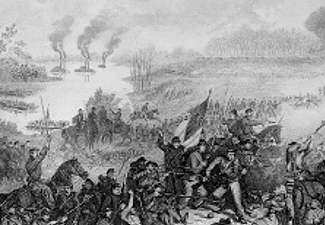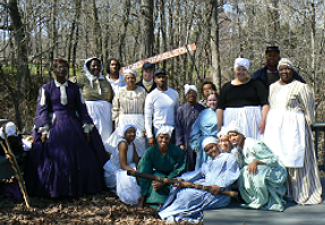-
Fort Donelson National Battlefield

Battle scene at the Battle at Fort Donelson, north of Nashville, Tennessee, in 1862.
Associate Pages
-
Visitor Statistics
166,026 visitors
Fort Donelson National Battlefield
#201 Most Visited National Park Unit
Source: NPS, Rank among 398 National Park Units 2024.
Park Size
959 acres (Federal); 1,029 acres (Total)
Park Fees
Free
Fees subject to change without notice.

Photo above: Reenactors and Visitors at Fort Donelson National Battlefield. Courtesy National Park Service. Right: Lithograph by Kurz and Allison of the Battle of Fort Donelson. Courtesy Library of Congress.

Fort Donelson National Battlefield
It was a battle that started to cement, even though a shock to the Confederacy and a boon to the north. The cement would be the beginning of the Union taking Tennessee, of Ulysses S. Grant cementing his place as a powerful general not only capable in the western theatre, but by the end of the war, of saving the Union from coast to coast. It was the Battle of Fort Donelson from February 11 to 16, 1862, that would provide, at least, the start of the bond, the concrete proof that despite many years of war ahead, that a complete Union might just be possible again.
Click here to Sponsor the page and how to reserve your ad.

Fort Donelson Then
The Confederate fort had taken seven months to build, begun in 1861, with soldiers and slaves preparing the fifteen acre earthen fort to protect this position along the Cumberland River from any possible Union attack. The vistas around the fort, with all trees felled within two hundred yards, would surely insure a victory against anything the Federal forces could provide. It would not be so in the end, although the first salvos of battle would inure the South into thinking that the fort would provide solace and victory, all this despite the fact that another fort, Fort Henry, had just succumbed to Union forces on February 6. However, Fort Donelson was larger, more impressive, and should be harder to defeat.
On February 14, the Union sent their ironclads and other vessels up the river to shell Fort Donelson under the command of General Andrew H. Foote. They would fight against the eleven large guns of the fort for one and one half hours, but be forced to retreat. However, while the Southern generals in command at the fort were pleased with this initial action and victory, it indicated a large problem brewing to their east. General Grant was getting reinforcement on his right flank, cutting off a possible route of retreat to Nashville for the Confederate forces and encircling the fort. On the morning of February 15, the South would try to break through while they still had the chance, and by the afternoon, had forced Grant to retreat. That retreat would not be the final bout, however, and a counterattack amidst the confusion of Confederate orders would close off the planned retreat route for most, although two thousand Rebel soldiers would make it out. For the others, over 12,000, they would become prisoners under the unconditional terms of surrender imposed by General Grant.
Fort Donelson would be the first major victory of the war for the Union Army. It would lead to Grant's elevation in stature, to the rank of Major-General, and later conquests. Kentucky and northern Tennessee would become a base for Union, not Confederate, operations. The war was beginning a slow turn.
Surrender Correspondence: From U.S. Grant
Sir: Yours of this date proposing Armistice, and appointment of Commissioners, to settle terms of Capitulation is just received. No terms except unconditional and immediate surrender can be accepted. I propose to move immediately upon your works.
I am Sir: very respectfully
Your obt. sevt.
U.S. Grant
Brig. Gen.
Reponse from Confederate General Buckner
SIR: - The distribution of the forces under my command, incident to an unexpected change of commanders, and the overwhelming force under your command, compel me, notwithstanding the brilliant success of the Confederate arms yesterday, to accept the ungenerous and unchivalrous terms which you propose.
How important was the Battle of Fort Donelson and what would its outcome portend? Nashville and Clarksville would fall within a week, with Nashville being the first Confederate capital to be captured. The Confederacy would know that keeping hold of a bellweather state would be difficult, if not eventually, impossible. And it would unleash that Unconditional Surrender General with a confidence that would lead to more Union victories.
Image above: Storming of Fort Donelson, 1862, Currier and Ives. Courtesy Library of Congress. Below: Huts at Fort Donelson National Battlefield, Carol Highsmith Colleciton. Courtesy Library of Congress.

Fort Donelson Now
There are eleven stops on the tour road that take you to the important sites on the battlefield such as the Union batteries that overlook the Cumberland River, the site of Smith's attack, the Dover Hotel (Surrender House), and the National Cemetery. If you want to venture outside the park's main border, you can visit the site of Nathan Bedford Forest's retreat across Lick Creek.
Prior to taking out on your auto tour, stop in the Visitor Center, which includes new exhibits installed for the 150th Anniversary, a film, and bookstore. Check for the ranger scheduled walks for the day (usually available from mid-June to September).
T-Shirts and Souvenirs

Fort Donelson National Battlefield T-Shirts and Souvenirs.

Fort Donelson
Things You Should Not Miss
1. Take a ranger guided tour, when available. The mid-June to September summer schedule usually includes several different ranger walks per day, including the River Batteries and Dover Hotel. Learning the battle from the words of National Park Service rangers is one of the best ways to get to know about the places and events of the park. Don't miss one, if available.
2. Visit the Dover Hotel. One of only four buildings to survive the Civil War in the town of Dover (due to the skimish known as the Battle of Dover in February 1863, not the Battle of Fort Donelson), this hotel was the headquarters of Confederate General Buckner and site of the meeting for surrender details after the Fort Donelson fray. Yes, details, not terms. General U.S. Grant would only take unconditional surrender as the terms, not negotiable, and over 12,000 Confederate prisoners would be transported from the area to northern towns as far away as Boston.
3. Orient yourself at the Visitor Center by watching the park film. It will give you a background to the battle, as well as the relationship between U.S. Grant and his Confederate counterpark, General Simon B. Buckner.
Photo above: Lithograph of the Battle of Fort Donelson. Courtesy Library of Congress.
Visitor FAQ

What's There Now
Fort Donelson National Battlefield
Visitor Center - Film that explores the relationship between Union General Grant and Confederate General Buckner, facilities, exhibits, and bookstore.
Remains of the earthen fort and its battery positions defending against attack from the Cumberland River.
Dover Hotel - This hotel was the headquarters of Confederate General Buckner, who was left behind (the other generals escaped to Nashville) to take the surrender from U.S. Grant. As you can see by his correspondece accepting the terms, he was not pleased at Grant. Buckner had previously stood up for Ulysses while both were in the Federal Army when charges of drunkenness were brought against him in California.
Six mile interpretive driving tour, including eleven points of interest.
Photo above: General Foote, commander of Union Ironclads at the Battle of Fort Donelson. Above right. General U.S. Grant. Both photos courtesy Library of Congress.

Directions to the Park
Fort Donelson is located north of Nashville in Dover, Tennessee. From Nasvhille, take I-24 west to Clarksville, Exit 4, left on Wilma Rudolph Boulevard. Right on Highway 374, then another right on Highway 79. It's about thirty miles to Dover from there. The park is one mile west of town. The total length of the trip from Nashville is about eighty miles and will take about an hour and one half.
Photo above: General U.S. Grant. Courtesy National Archives.

Lodging and Camping
Dover is a very small town, a little over 1,000 people in population and there are few lodging choices. You may end up staying twenty-five to thirty miles away in Oak Grove, Murray, or Paris. Check out your favorite online lodging site such as Expedia for the lodging type of your choice.
Camping is more plentiful nearby, particulary in the Land Between the Lakes National Recreation Area, Piney Campground, where there are 384 sites. There is a smaller campground even closer, LBL Whispering Pines, and others in the area as well. We've not been to any of these, so do your own research about whether they're right for you.
Drawing by William Momberger (1862) of the storming of Fort Donelson by Union troops. Image courtesy of the Library of Congress.

More Photos of the Park
Above: Living History interpreters at Fort Donelson. Courtesy National Park Service.
About
America's Best History where we take a look at the timeline of American History and the historic sites and national parks that hold that history within their lands.
Photos courtesy of the Library of Congress, National Archives, National Park Service, americasbesthistory.com and its licensors.
- Contact Us
- About
- © 2025 Americasbesthistory.com.
Template by w3layouts.
